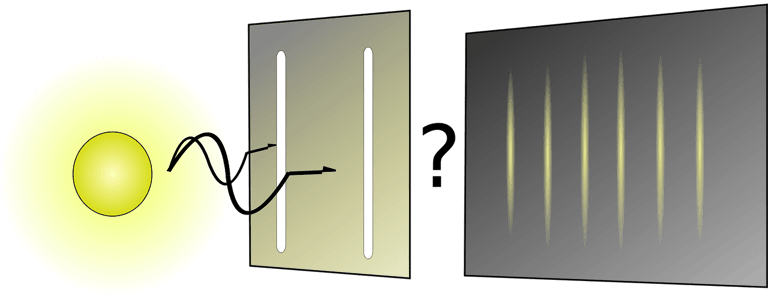👁️ The Observer Effect and the Dance of Consciousness
A Page in Similarity Theory
By Simon Raphael
🌀 Philosophical Framework
🔦 When Observation Shapes Reality
In classical physics, matter was thought to move according to fixed, mechanical laws whether or not anyone was present to watch. Yet the famous double-slit experiment revealed something startling. When electrons or photons pass through two slits unobserved, they form an interference pattern, behaving like waves spread through possibility. But when they are measured, the wave pattern collapses — they behave as if they “know” they are being observed.
The observer effect suggests that awareness is not passive but active. Observation changes what is observed.
🖼️ Frames, Collapse, and Becoming
Similarity Theory explains this mystery through its concept of frames of existence. All possible frames exist in timeless stillness, like unlit lanterns awaiting a spark. Consciousness is that spark. When observation occurs, one frame illuminates. Possibility collapses into actuality.
Without observation, particles resonate across many frames simultaneously, like a violin string vibrating with multiple harmonics. With observation, one note is struck — clear, singular, and lived.
Thus, the observer effect is not a laboratory curiosity but a window into the architecture of the cosmos. Consciousness does not merely record reality; it crystallises it by selecting frames.
🌌 Time as Stillness and Emergence
If all moments of time exist eternally, like still images on an infinite film reel, then consciousness is what moves through them — choosing, animating, and expanding them.
From the human perspective, the universe may have “waited” billions of years for emptiness to awaken. From the perspective of emptiness itself, there was no waiting. One glance — one act of self-recognition — and existence began.
The double-slit experiment reflects this paradox: potential stretches infinitely, yet its collapse into reality feels instantaneous. Time is both immeasurable and absent, depending on the frame.
Analogy: Like a book that already contains every page, time is complete. But reading it — turning pages in sequence — is the act of consciousness bringing the story to life.
🔗 Entanglement: Mirrors Across Space
Quantum entanglement deepens the mystery. Two particles, once linked, remain connected even across vast distances. Measure one, and the other “knows” instantly, no matter the separation. Einstein called it spooky action at a distance.
In Similarity Theory, this is no longer spooky but expected. Entangled particles share frames; to observe one is to collapse both simultaneously. Consciousness threads them together beyond the speed of light, because it is not bound by space-time.
Analogy: Imagine two mirrors facing each other. Touch one, and the reflection shifts in both. Entangled particles are not two separate objects but reflections of one deeper whole.
🔮 Knowing Before Knowing: Consciousness and Foreknowledge
Some experiments suggest that particles “decide” how to behave based on future measurement — as if reality knows ahead of time what will be observed. The delayed-choice quantum eraser shows that even choices made after a particle has passed through slits can determine whether it behaved like a wave or particle.
In Similarity Theory, this is natural. If all frames exist timelessly, then the choice of observation is already woven into the tapestry. Consciousness selects not only in the present but across the web of time.
Analogy: A reader flips through a novel and then decides to return to an earlier page. The characters’ story seems to have “already known” the ending, because the ending always existed — the reader simply chose when to reveal it.
🪞 Consciousness as the Universal Mirror
Observation is not mere perception — it is creation. Each act of awareness activates a frame and threads it into causality. The observer is not an outsider but a co-creator of the unfolding cosmos.
Consciousness is the mirror of the universe: it lights frames, merges probabilities, and shapes becoming. Like droplets fusing into a river, every act of observation folds infinite possibilities into one flowing reality.
🔬 Scientific Grounding
Double-Slit Experiment: Demonstrates that unobserved particles behave as waves, but collapse to particles when observed.
Quantum Entanglement: Experiments (e.g. Aspect, 1982) confirm instantaneous correlations across distance, defying classical locality.
Delayed-Choice Experiments: Wheeler’s proposals and later quantum eraser experiments show outcomes can depend on future observations.
Interpretations: Copenhagen, Many-Worlds, and “It from Bit” all attempt to explain the role of observation — Similarity Theory reframes it as the illumination of frames by consciousness.
📖 References
Young, T. (1801). Original Double-Slit Experiment on Light Interference.
Feynman, R. P. (1965). The Character of Physical Law. MIT Press.
Aspect, A. (1982). Experimental tests of Bell’s inequalities using entangled photons. Physical Review Letters.
Wheeler, J. A. (1978). The “It from Bit” Hypothesis.
Raphael, S. (2025). Similarity Theory: Dimensions, Time, and Consciousness.



